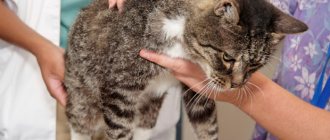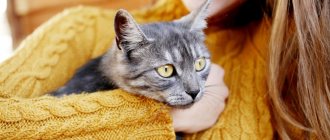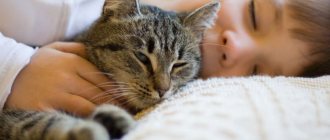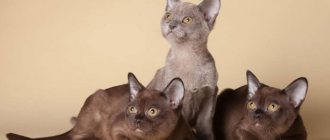The vast majority of people believe that our smaller brothers, namely cats, do not know how to express their feelings and moods. But this is not true at all. Cats' body language is very simple. The emotions of cats are very understandable and accessible to everyone.
To do this, you just have to watch carefully, and you will learn to distinguish, how to understand the cat's language. It is expressed primarily in the way the cat shakes its tail. But let's take a closer look at how and why cats shake their tail.
Fear
Fear is one of the most powerful reactions, since it is generated by the instinct of self-preservation and is associated with a powerful hormonal release in the body. This feeling makes one literally turn to stone on the spot, and the whole cat’s face turns out to be the personification of the saying: “Rhinestone has big eyes.”
Externally, fear is expressed:
- increased muscle tone;
- stiffness of movements;
- head pulled into shoulders;
- rounded eyes, widely dilated pupils;
- ears down;
- with its tail between its legs (read the article on how to understand a cat by its tail).
A frightened cat is silent or makes abrupt, muffled sounds.
How to understand what a cat wants?
Although cats may seem mysterious, by carefully observing their behavior you can understand how they feel. The position of the body, head, ears and tails are hints. An anxious or frightened cat may sit down on the ground, arch its back, lower its head, and straighten its ears. By the way, people are not so different from cats - when we are scared, we also retreat back, hide, the hair on our body stands on end (this is called piloerection), and we can also fight and even bite. As for cats, when they are happy, they may approach you with their tail up and ears forward. When cats are at rest, they curl their paws or lie on their sides with their legs extended.
A cat's facial expression can also tell a lot about its mood. Researchers have found that some people can easily tell when cats are in pain. Despite this, the full range of facial expressions in cats, including in positive situations, has not been thoroughly examined.
By the way, on our Yandex.Zen channel you will find even more interesting articles about the relationship between man and our little brothers.
This cat is probably very unhappy about something.
During the online study, subjects were shown short videos of cats in various situations. Positive situations included cats approaching their owner for a treat, while negative situations included cats trying to avoid meeting a person unknown to them. The videos were carefully selected based on strict behavioral criteria and edited so that subjects could only see each cat's face, removing any other cues from the animals' body language or location.
More than 6,300 people from 85 countries took part in the study. Subjects determined whether the animal's mood in each video was positive or negative. By the way, if you want to try your hand at this difficult task, you can do it right now.
And the results obtained can be shared in the comments to this article, as well as with participants in our Telegram chat.
On average, participants identified the correct cat facial expression 59% of the time. While this estimate is little better than a common guess, it does suggest that many people have difficulty recognizing cats' emotions. However, despite the fact that most of the subjects found it difficult to understand the mood of cats, 13% turned out to be real charmers, scoring 15 or more points out of a possible 20. Mostly women fell into this group, which, according to the researchers, is not surprising - previous Research has shown that women are better at interpreting nonverbal emotional cues.
But for this guy, on the contrary, things are going uphill
Veterinarians and people who deal with large numbers of cats every day and must learn to interpret their behavior and recognize diseases also did an excellent job. What's even more surprising is that cat owners aren't as good at recognizing their pet's emotions as those who've never had a cat at home. According to researchers, this situation may be due to the fact that we recognize the emotions of our animals well, but problems may arise with interpreting the emotions of unfamiliar cats.
Anger
Irritability can quickly turn into anger if the animal is not left alone. Increased negative emotions are indicated by:
- tail moving with a large amplitude from side to side;
- ears pressed to the head;
- point-blank gaze;
- front paw raised for protection;
- arching of the back;
- hiss;
- angry guttural sounds similar to howling.
"Her Majesty is dissatisfied"
The cat may be unhappy, especially if it believes that it was punished unfairly, and this will be in almost 90% of cases. Then she turns her back to the owner and begins to lick the fur. So she shows whim and wants the owner to fuss, paying attention to her and showing favor. As soon as the owner has done this, forgiveness has been received, you can continue communication as before.
Understanding how to determine a cat’s mood by its gestures and glances helps you establish contact with this simple-minded and at the same time complex animal, understand its desires and know what to expect from your pet. After all, understanding makes us closer.
Ready for battle
Cats are very cautious animals, so in a dangerous situation they choose to camouflage and wait, or flee.
However, when cornered, they fight back using their natural arsenal of 20 hooked claws and fanged mouths. A cat ready to fight signals its serious intentions:
- deep visual concentration on the opponent;
- ears pressed to the back of the head;
- bared mouth and hissing;
- strikes with the front paw with extended claws;
- tipping over onto your back with half-bent tense legs;
- a drawn-out battle cry;
- lightning jump attack.
Do people react to sadness?
Cats are considered to be great healers. The frequency of a cat's purring is 24 Hz, which is quite enough to balance the energy background of diseased human organs. The fact is that the cat perfectly senses the frequency of vibration from unhealthy cells and tries to align them. That is why cats lie on the sick organs of their owners and sleep with them during illness.
The nature of understanding the owner's deep emotional state is of the same nature. For us, sadness often comes after a severe stressful situation. At this moment, the human body vibrates in a completely different way, which the cat reads well. With a cute purr and a soft massage with his paws, he tries to normalize the energy state of his beloved owner.
Disappointment
Sometimes cats can become bored, resentful and upset. Gray emotions such as disappointment, sadness and despondency are clearly illustrated by “body language”:
- a faded, absent look;
- ears turned to the sides;
- hunched posture;
- reluctance to play and move actively;
- tail down.
An increase in such signs in combination with disturbances in natural functions, loss of appetite and elevated body temperature indicates a serious illness of the animal and requires the intervention of a veterinary specialist.
Jealousy
Cats express their jealousy very clearly. If a child or a new pet appears in your family, the cat clearly begins to show indignation. To the cat, he is the owner of the apartment and royalty, so he believes that you should consult with him about such changes in life. In this case, the cat may begin to shit. But do not rush to part with the animal, it will definitely get used to the new circumstances. This is a huge stress for him, so you need to be tolerant and understanding.
Cats experience both joy and sadness, they can experience different feelings and emotions, and can truly love. If you love them back, they will definitely repay you.
Playful mood
Kittens play at any age, stretching their muscles and satisfying the “beast in themselves,” but for growing kittens, games are a way to explore the world.
Sometimes cat fun can be too violent, fueled by the hunting instinct and ending with torn curtains or torn upholstery of a new sofa. Wanting to play, the cat takes a typical pose, which is characterized by:
- gaze focused on potential “prey”;
- forward-pointing ears;
- twitching tail tip;
- moving around the apartment in quick leaps;
- sudden attacks from shelters as an element of “hunting” for a broom, a vacuum cleaner brush or the owner’s feet;
- capturing “prey” with all four paws and teeth.
"Weather in the house"
A very important factor in a cat’s friendliness is how the household behaves. If quarrels and scandals constantly arise, the atmosphere is tense, and all family members demonstrate aggressiveness, you should not hope that the cat will be able to improve the emotional atmosphere. The pet tries in every possible way to help its owners, but not everything is in their power. They seem to be saturated with negative energy and become just as nervous and aggressive. Therefore, it is very important that everything in the house is quiet and calm. Cats will feel great and will be able to give you many pleasant moments of communication with them.
This narrow house seems inconspicuous only from the outside, once you look inside
A pregnant wife spent a week wearing what her husband chose for her: what she had to wear
How you like it: Indian chef showed how to boil eggs (video)
Why do cats wag their tails?
The cat waves its tail differently, the movements reflect a certain emotion, positive or negative. The cat shakes its tail with a certain intensity, proportional to the strength of the emotions experienced.
Kittens often catch and bite their own tail, which acts as a toy and helps them acquire hunting skills.
Since a cat has an individual character and behavior, tail movements may not mean what is commonly believed. Therefore, it is recommended to determine cat emotions from your own experience, focusing on the information presented.
Positive reasons
There are many positive reasons why cats noticeably wag their tails:
- are in a playful mood and invite you to play;
- express love for the owner and household members (the vertically raised tip trembles);
- show interest, curiosity (slight twitching);
- they feel happiness, satisfaction, express complete calm (they move only the tip of their tail);
- express friendliness and trust (the caudal vertebrae are parallel to the floor);
- experience the excitement of the hunt, observe a potential victim - a mouse, a fly, a bow on a rope;
- are thoughtful (broad, relaxed movements);
- feel satisfied, want to communicate (the caudal process is lowered, relaxed);
- feel superiority and security, are confirmed in leadership (hold the organ like a “pipe”);
- thank the owner for his care and affection (the cat slowly and smoothly waves its tail).
Negative reasons
For both negative and positive reasons, a cat often wags its tail:
- dissatisfied, angry (swings sharply and actively in the horizontal direction);
- experiences aggression, irritation (lowered, nervously hits the floor);
- is in a stressful state, shocked (hitting the floor intensely, chaotically);
- got scared (squeezed);
- warns, preparing for a jump, attack (movements accelerate);
- very angry, ready for a furious attack on the enemy (the tail is directed upward, motionless, may twitch slightly, the fur is tousled);
- feels danger, is ready to defend itself (the caudal vertebrae are directed upward, arched);
- affected by skin parasites (the skin twitches, the cat constantly itches, gnaws, the character becomes restless);
- sexual desire, estrus is the physiological reason why a cat’s tail shakes convulsively (the pet bends its hind limbs, raises the shaking appendage of the spine).
In addition to the period of estrus, cats shake their tail, as if marking, when experiencing severe pain.
The appearance of strangers
We are talking about different situations that can affect the behavior and character of a cat. For example, coming to the house of strangers. Cats very slowly get used to people because they are independent and somewhat capricious creatures. When different people with different energy levels visit the house, the cat feels extremely uncomfortable. She can either hide in a secluded place (for example, under the bed), or begin to show aggression (hiss, scratch, bite, etc.).
Cappuccino cake has two main advantages: it is moderately sweet and very tasty.
Mazda SUVs will be rear-wheel drive by 2022 with Skyactiv-X engine
Capital schoolchildren will return to full-time learning from January 18











